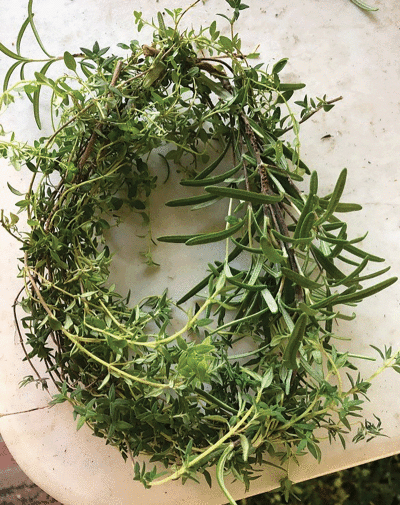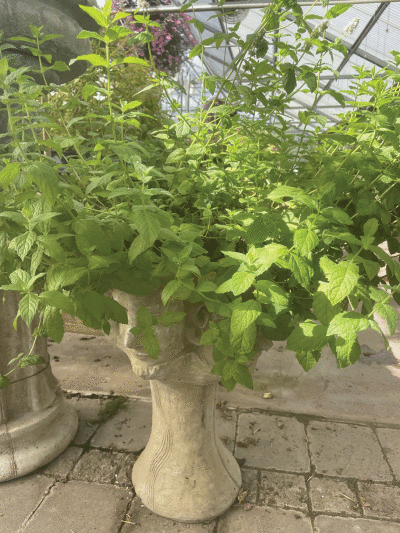
Thyme is woven into a wreath, which, on a smaller scale, can be used for seasoning a soup in the winter.
Photo provided by Piechnik’s Greenhouse and Garden Gate in Oakland Township

Planted peppermint at Piechnik’s Greenhouse and Garden Gate in Oakland Township.
Photo provided by Piechnik’s Greenhouse and Garden Gate in Oakland Township
METRO DETROIT — Colder weather is on the horizon, but that doesn’t mean you have to say goodbye to the flavors and scents you love from your outdoor herb garden.
To enjoy herbs all year, local gardening experts suggest potting them and bringing them indoors before the first big frost arrives.
The best herbs to move indoors for the winter, according to Rebecca Krans, a consumer horticulture educator with the Michigan State University Extension, are healthy perennials that need protection from freezing temperatures to survive.
Herbs such as basil, thyme, sage, parsley, oregano and rosemary can all flourish in a sunny kitchen window during Michigan’s harsh winters.
But before you bring your plants indoors, be sure to inspect them for insects, knocking off any bugs you see with water from your garden hose.
Then, anytime before the ground freezes, you can dig up the herbs to bring inside. Simply place them in potting soil inside a pot — with a hole at the bottom — that’s large enough to fit the plant’s roots and still allow room for growth.
“Putting them all in one giant pot can be intimidating, so I just use smaller window pots,” said Amy Carrier, the head designer at Piechnik’s Greenhouse and Garden Gate in Oakland Township.
For your herbs to flourish, they will need a good, south-facing window with at least six hours of direct sun each day. Turning pots once a week will help all sides of your plants get enough light.
“The sun moves around during the winter and some windows get more sun than others, so you can experiment with moving them to different windows to make sure they get a couple hours of full sun,” Carrier added. “As long as they are getting some sun, they will do well.”
Those without a good south-facing window can provide light artificially by placing cool fluorescent bulbs, or newer LED grow lights, about 6-12 inches from the leaves of the plant.
“Putting those lights on for 14-16 hours is going to make them more successful during the winter,” Krans noted.
Watering is also key, she said. Remember to water, to a depth of 1 inch, when the soil feels dry.
“A lot of herbs do not like to have wet feet, but yet, they do like some humidity, so that’s why it’s difficult in a lot of our winter homes that may be drier,” Krans explained. “A good suggestion for herbs is putting the plant pots in a pan with some smaller pebbles. That way, the pots are not sitting directly in the water, but instead sitting on the pebbles that maybe have some water below them. That way, the water can evaporate and that provides a little extra humidity into our dry winter homes — which is especially important for rosemary.”
If you missed the opportunity to bring your garden herbs indoors, Krans said you can start some herbs inside from seed in the winter — like basil, parsley, cilantro, oregano and sage.
“There are some different seed-starting kits out there — which are usually soilless mixtures to start your seeds — so it’s important to keep that moisture in, even covering it with Saran wrap, or some of the kits even have domes,” Krans said. “You keep it covered until you start to see the green of the seeds that have germinated, and then you slowly remove that so that the plants can get adapted and they don’t have the moisture sitting on the leaves, which causes the mold and disease organisms.”
Herb seedlings require six hours of direct light, which can be achieved in a south window, or seedlings can be placed under two 40-watt white fluorescent bulbs for 14-16 hours. The room temperature for herbs needs to be at least 65-70 degrees in the day and 55-60 degrees at night.
“If at first you don’t succeed, try, try again. That’s part of the fun with gardening,” Krans said.
For more information about gardening in Michigan, visit www.migarden.msu.edu or call the gardening hotline at (888) 678-3464.
 Publication select ▼
Publication select ▼






















